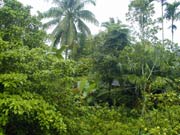|

|
|
Traditional Ecosystem of Dai People |
|

|
Though the minorities of Xishuangbanna have left the rain forests and have developed agriculture quite a long time ago; their necessities for daily life today still depend on the plant and animal resources of the rain forests in a large extent, and their production mode still has a strong stigma of the rain forest. Forest tilling is an important method for agricultural production for them until today. One of their farming methods is to clear out the trees in an area of 3-5 mou in the rain forests; inside such a "forest window", they will grow tea plants; during this process, some tress are left in the window. Since the tea plants get appropriate shady and humid conditions required for their growth, as well as fertile soils, the quality of the tea produced there is superb, and the tea plants are also free from harms caused by insects or diseases. Therefore, the "six tea mountain slopes" in Xishuangbanna became the native lands of the famous "Puer Tea" in history. The second method is to clean the shrubs and herbs in the forests, plough the fields up, and then plant
(Baphicacanthus cusia)acanthaceous indigo to produce some blue dyes for yarn-dying of their homemade cloth; and acanthaceous indigo is also the raw material for the Chinese medicine - Ban Lan Gen. The third method is to dig planting holes beside some trees for the planting of various vine plants, and use the trees as the frames for the vines to climb up; in this way, they can produce vines for weaving various furniture and farm tools. The traditional farming methods are methods of sustainable use of the rain forests under the prerequisite of harming no natural environments. However, in the recent years, many
(Amomum villosum) fructus amomi and (A. kravanh) Amomum cardamomum were planted in the rain forests, since they grew too prosperously and there were too much of them, the growth of young trees under the forests were affected. This also affected the renewal of the forests.
 |
|
A Curtilage of Dai People
|
All ethnical groups living in the sea of forests are quite familiar with the plants of the rain forests and their biological structures; they also apply such knowledge to their agricultural practices. They plant
(Cinnamomum spp.) camphors and tea plants in the same field according to regular spaces, and form artificial woods of more than two layers. The tea plants have no impacts on the growth of the camphor on one hand; on the other hand, they can also find proper shelter under the camphor, therefore, both their quality and their yields all improve. The branches cut down from camphor trees can produce camphor products, and at the same time, sparse branches also improve the lighting condition of the rain forest in a period of time, which is beneficial for the growth of tea plants too. We can say that they bring out the best in each other, and the farmers can obtain tea and camphor at the same time. Concurrently, the fallen leaves of the two types of plants will go back to soil and make the soil richer. To some extent, this farming method reduces the loss of soil and water, and ensures the sustainable use of resources. It is also a successful example for the forest nations of Xishuangbanna to learn from the forests and to develop bionic agricultures.
 |
|
Plants Growing in
the Curtilage of Dai People
|
Another example for applying bionic agricultural knowledge to production is: the ethnical folks all build a family yard beside their houses. Smaller yards are as big as 0.1-0.2 mu and the larger ones are as big as 0.3-0.4 mou each; within the yard, they will plant small and middle arbor trees for the upper layer, such as cocoanuts, betel nut, grapefruit, mango, and pineapples; in the lower layer, they will plant shrubs and herbal economic crops, such as sugar cane,
(Crataeva uniloculeris), and (Cymbopogon citratus) citronella etc. Within one yard, the plants strew at random, including fruits, vegetables, spices, medicinal and ornamental plants, and each is in its proper place. The local residents can also use their spare time to cultivate and manage the plants in their yards. The products, besides satisfying the needs of each household, can also be exchanged with relatives and neighbors, or sold on the market. According to our statistics, the plants growing in the family yards of Xishuangbanna total to more than 400-500 varieties, so the yards of the households have become important gene storehouses of various plants. The researchers of Xishuangbanna Tropical Botanical Garden also select and cultivate some important economic crops, such as
(Cananga odorata), which has developed to thousands of mou in Xishuangbanan; and the Banna grapefruit, which has developed to 30,000-40,000 mou in South Yunnan, and has become a special fruit of
Xishuangbanna.


|